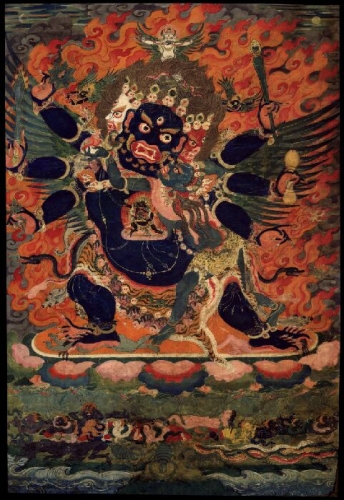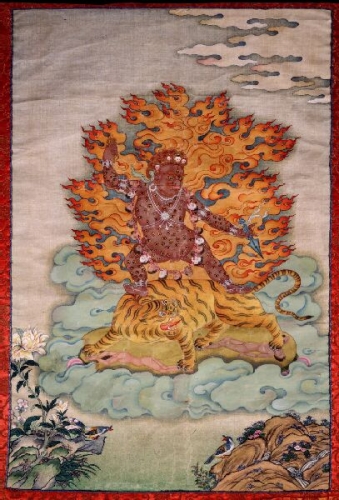Buddhist practice and Buddhist art have been inseparable in the Himalayas ever since Buddhism arrived to the region in the eighth century. But for the casual observer it can be difficult to make sense of the complex iconography. Not to worry—Himalayan art scholar Jeff Watt is here to help. In this “Himalayan Buddhist Art 101” series, Jeff is making sense of this rich artistic tradition by presenting weekly images from the Himalayan Art Resources archives and explaining their roles in the Buddhist tradition.
Meditational Deities of Tibet

Since tantric Buddhism originates in India, it follows that its meditational deities should also be of Indian origin. For the most part this is true except for when it comes to the Nyingma tradition of Tibetan Buddhism. The Nyingma, or “ancient ones,” is a term that designates the earliest forms of Buddhism in Tibet prior to the arrival of the new tantras (sarma) from India beginning in the 11th century. Following the arrival of the new tantras and the schools that formed around them—such as the Sakya, Kagyu, Jonang and Gelug—the Nyingma tradition of “revealed treasure” (terma) came into full bloom in competition with the others’ growing popularity and influence.
After the 11th century the Nyingma tradition began to have a strong belief in terma, which can be generally understood as divine inspiration or revelation. The texts and subjects of terma are believed to be composed or created by the 8th century teacher Padmasambhava, who hid them either in isolated physical locations or in the mental continuum of particular followers.
This unique tradition of Buddhism has led to the creation of many forms of deities. Some forms are variations on old themes. For example, the Black Yamari figure shown at right, with three faces and six hands in fearful appearance, is a terma meditational deity based on the Indian models of Krishna (black) Yamari (killer of death): an emanation of the enlightened deity Manjushri.
The most recognizable feature for all forms of Black Yamari, Indian and Tibetan, are the prone buffaloes underfoot. A special visual feature associated only with terma meditational deities is the appearance of the mythical Indian Garuda bird above the central figure. In this case there are three birds, pinkish in color. The different lineages of terma traditions can be distinguished by the specific color of the garuda birds flying overhead.

Another good example of new deity forms are the different appearances of Padmasambhava. Although originally understood to be a human being and Buddhist teacher from India, after the 11th century he became increasingly deified and depicted in dozens, if not hundreds, of various deity forms. In orthodox Nyingma descriptions the great commentators of the past have been very careful to refer to these different forms of Padmasambhava, some peaceful, some wrathful, not as meditational deities (yi dam), but as forms of the teacher for use in Guru Yoga practice.
Regardless of classification, the various artistic representations of Padmasambhava vary little, if any, from general deity appearance. The example at left is of Dorje Drolo, Padmasambhava, as he appeared at thirteen different locations in Tibet and the surrounding Himalayan regions. Currently the most famous of these locations is located at Paro Taktsang in Bhutan.
There are eight principal deity forms of Padmasambhava. Dorje Drolo is one of those eight, each of which represent a major event in Padmasambhava’s life story. Here Dorje Drolo is wrathful in appearance, naked, the body covered with eyes, riding atop a pregnant tigress. This form of the naked deity with eyes is highly unusual and only belongs to one specific terma tradition. Typically in the other terma lineages the form of Dorje Drolo would be fully clothed and only have three eyes.
Thank you for subscribing to Tricycle! As a nonprofit, we depend on readers like you to keep Buddhist teachings and practices widely available.